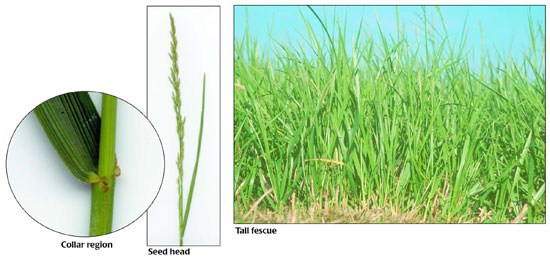Taking an environmentally sensitive approach to pest management
Forage of the Month: Tall Fescue
Published: April 21, 2011
Tall Fescue (Festuca arundinacea Schreb.)
Tall fescue is one of the most popular grasses in the United States. It is grown on more than 34 million acres nationwide. Because of its hardiness and adaptability, it is used for several purposes, including silage, hay, pasture and erosion control. Tall fescue is most nutritious in early spring and again in autumn. In addition, tall fescue has a waxy leaf surface that helps it retain its forage quality through winter better than any other perennial grass. As a result, many producers stockpile tall fescue for deferred grazing in winter.
There are also many negatives associated with tall fescue. This cool-season grass does not provide a quality habitat for wildlife. In addition, most tall fescue is infected with an endophyte, a fungus that produces compounds that are toxic to cattle. If cattle eat tall fescue that carries the endophyte, they exhibit reduced weight gains and reduced milk yields as well as a number of more serious illnesses such as fescue foot. Although endophyte-free tall fescue does not have this problem, it does not persist as well as tall fescue that contains an endophyte. There are new varieties of tall fescue that contain nontoxic endophytes. These varieties are reported to give good livestock performance and persist longer than endophyte-free types.

Origin: Europe
Adaptation to Missouri: Statewide
Growth habit: Rhizomatous, nearly sod-forming, perennial bunchgrass.
Blade: Rolled in bud shoot, ribbed and somewhat rough top surface, glossy lower surface, prominent midrib and veins, margins scabrous.
Sheath:Round, generally smooth, split, large.
Ligule: Truncate, membranous, up to 1/10th inch long.
Auricles: Small, short, pubescent.
Seed head: Contracted panicle.
Fertilization: 40 to 60 lb N/ acre mid-August for fall or stockpile pasture. In spring, 40 to 60 lb N/ a cre after the first grazing or harvest. If pasture is lacking, follow with another 40 lb N/ acre after the second grazing . Phosphorus and potassium to soil test.
Timing of production: Produces 70 percent of its growth between April 1 and June 15.
When to begin grazing: When the grass reaches 6 to 8 inches in height.
When to cut for hay: Late vegetative to early boot stage.
Lowest cutting or grazing height: 3 to 4 inches

Yield distribution of tall fescue in Missouri.
Subscribe to receive similar articles sent directly to your inbox!
REVISED: October 2, 2015